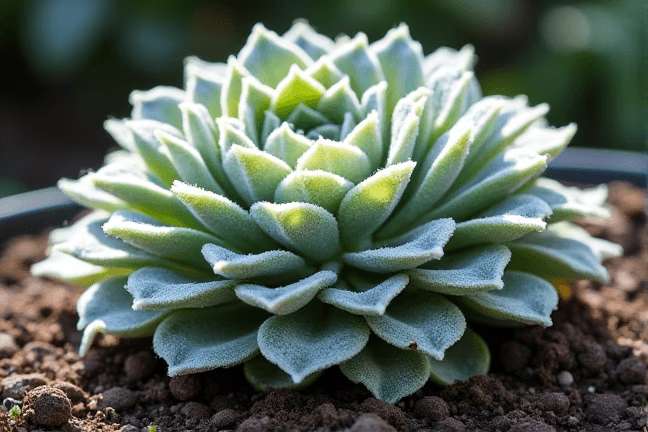
Dusty Miller
Cineraria maritima
Grow Time
90-120 days
Sunlight
Full Sun
Watering
Every 7-10 days
Toxicity
Non-toxic
How to plant Dusty Miller: Step-by-Step Guide
Growing Guide
Preparation

What you'll need:

Dusty Miller seeds or young plants (available at garden centers or nurseries)

A pot or garden space with good drainage

General-purpose potting soil (light and well-draining works best)

Watering can or hose
- Sunny to partially shaded spot
When to start:
Dusty Miller thrives in cooler weather, so spring or early fall is the perfect time to plant. If you're starting indoors, sow seeds about 6-8 weeks before the last frost date in your area.
Choosing a location:
Dusty Miller loves sunlight but doesn’t mind a bit of shade either. It’s important to find a spot where it gets at least 4-6 hours of sunlight daily. If you're planting in pots, make sure they have drainage holes to prevent soggy soil, which Dusty Miller dislikes.
Tip: If you’re using seeds, sprinkle them lightly on the soil surface since they need light to germinate. Don’t bury them too deep!
Planting

If starting from seeds:
- Fill small pots or seed trays with moistened potting soil.
- Sprinkle the seeds evenly over the soil surface—don’t cover them with soil because they need light to sprout.
- Mist the soil gently to keep it moist but not soaking wet.
- Place the pots in a bright spot, like a windowsill, where they’ll get plenty of light.
- Seeds should sprout within 7-14 days if kept warm (around 65-70°F/18-21°C).
If using young plants:
- Dig a hole slightly larger than the root ball of the plant.
- Gently remove the plant from its nursery container and place it in the hole.
- Backfill with soil and press down lightly to secure the plant.
- Water thoroughly after planting.
Spacing tip:
If you’re planting more than one Dusty Miller, leave about 12-18 inches (30-45 cm) between each plant. This gives them enough room to grow without overcrowding.
Growing Care

Watering:
Dusty Miller doesn’t like wet feet, so water sparingly. Let the top inch of soil dry out between waterings. Overwatering can cause root rot, which is something you definitely want to avoid.
Sunlight:
This plant enjoys full sun but can handle partial shade, especially during the hottest part of the day. In very hot climates, some afternoon shade will help keep the leaves looking fresh and silvery.
Feeding:
Dusty Miller isn’t a heavy feeder, so you don’t need to fertilize often. If you want to give it a boost, use a balanced liquid fertilizer once a month during the growing season (spring and summer). But be careful—too much fertilizer can lead to leggy growth rather than that nice bushy shape you want.
Pruning:
To encourage a fuller, bushier plant, pinch back the growing tips when the plant is young. Simply snip off the top set of leaves on each stem. This will promote more side shoots and give your Dusty Miller a denser appearance.
Tip: Remove any yellow or dead leaves regularly to keep the plant looking tidy.
Harvesting

While Dusty Miller isn’t typically grown for harvesting (it's mostly used as an ornamental plant), you can still enjoy its beautiful silvery foliage by cutting stems to use in flower arrangements!
How to cut:
- Use clean scissors or pruning shears to cut stems early in the morning when the plant is most hydrated.
- Cut just above a leaf node (where the leaves meet the stem) to encourage new growth.
- Place the stems in water immediately to keep them fresh for your arrangements.
Tip: Even though you're not "harvesting" in the traditional sense, regular trimming helps maintain the plant’s shape and encourages healthy growth.
Plant Care FAQ
Q: Why are my Dusty Miller’s leaves turning yellow?
A: Yellowing leaves could mean overwatering or poor drainage. Make sure the soil is drying out between waterings and that your pot or garden bed has good drainage. Cut back on watering if necessary.
Q: Can Dusty Miller survive frost?
A: Dusty Miller can tolerate light frosts but won’t survive hard freezes. If frost is expected, cover the plant with a cloth or bring potted plants indoors temporarily.
Q: How do I keep Dusty Miller compact and bushy?
A: Regular pruning or pinching back the growing tips will encourage the plant to branch out and stay dense. Prune every few weeks during the growing season.
Q: Does Dusty Miller attract pests?
A: Generally, Dusty Miller is pest-resistant due to its fuzzy, silvery leaves. However, watch out for aphids or spider mites in very dry conditions. A quick spray of water or insecticidal soap can take care of these issues.
Q: Can I grow Dusty Miller indoors?
A: Yes! As long as it gets enough light (a sunny windowsill is ideal), Dusty Miller can thrive indoors. Just be mindful not to overwater.
Pro Tips
1. Companion Planting
Dusty Miller makes an excellent companion plant for colorful flowers like petunias or marigolds. Its silvery foliage contrasts beautifully with bright blooms, making your garden pop!2. Drought Tolerant
Once established, Dusty Miller is quite drought-tolerant. This makes it perfect for low-maintenance gardens or areas where you might forget to water frequently.3. Deer Resistant
The fuzzy leaves of Dusty Miller are unappealing to deer, making it a great choice for gardens in areas with lots of wildlife.4. Container Gardening
Dusty Miller does exceptionally well in containers. Pair it with other sun-loving plants like geraniums or verbena for a stunning display on your patio or balcony.5. Coastal Gardens
Native to coastal regions, Dusty Miller tolerates salty air and sandy soils, making it ideal for seaside gardens.6. Edging Plant
Use Dusty Miller as an edging plant along pathways or garden borders for a neat, silvery outline that complements other plants.7. Low Fertilizer Needs
Dusty Miller doesn’t require frequent feeding. A little neglect can actually lead to a healthier, more robust plant!